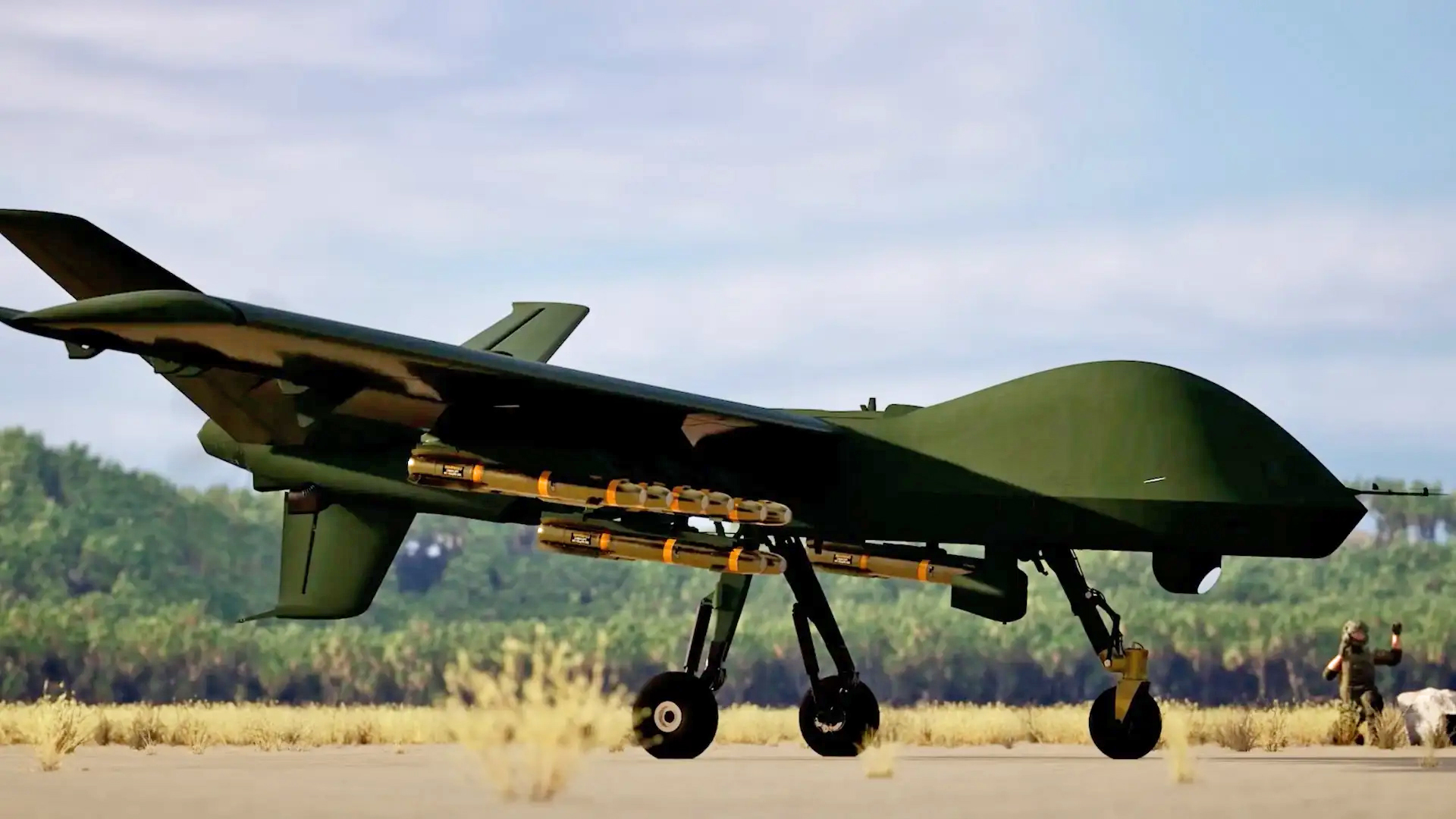General Atomics has released a computer-generated video showing a concept of its Mojave unmanned aircraft being rapidly deployed to a remote location by a C-130 Hercules cargo aircraft. So far, one Mojave drone has been built by General Atomics and the type is continuing its flight testing and development.

Mojave, which is derived from the MQ-1C Gray Eagle that the company developed for the U.S. Army, was first unveiled by General Atomics Aeronautical Systems (GA-ASI) in late 2021. Mojave has the ability to perform short takeoffs and landings from various rough and semi-prepared operating areas, and can be ready to fly from austere locales in as little as 1.5 hours once rolled out the back of a C-130, according to General Atomics. This makes Mojave ideal for different sorts of distributed and expeditionary operations, such as those that have become a top priority of the Air Force and the U.S. Marine Corps.
In the video, we see a CGI C-130 approaching an austere location before landing. From there, a cutaway of the aircraft from the side shows Mojave in what the video caption describes as “preconfigured readiness posture” inside the C-130’s cargo bay. Essentially, this means the unmanned aircraft can be transported in ‘flatpack’ form with its wings tucked to its sides, where it can be quickly assembled and put into action. Mojave’s ground support equipment is small enough to be transported by a single UH-60 helicopter.

Panning to the interior of the C-130’s cargo bay, we then see a four-person team unloading Mojave before setting to work on its assembly.


The unmanned aircraft’s wing is then slotted into place by the individuals using moveable supports, as well as its rear tail. As we have noted in the past, Mojave’s fat rectangular wing certainly gives it the look of the OV-10 Bronco. Those wings feature double-slotted flaps and leading-edge slats for maximum lift in short takeoff and landing scenarios.

As a final part of the assembly process, the video shows two members of the team loading an AGM-114 Hellfire missile underneath one of Mojave’s underwing pylons.

When GA-ASI first publicly unveiled Mojave in 2021, the company placed particular emphasis on its ability to support 16 Hellfire missiles across its six underwing pylons. The recent video shows the CGI Mojave equipped with eight of those missiles under both wings, for a total of 16.

Of course, Mojave can be customized to carry a range of other precision-guided weapons and podded systems, depending on the customer’s needs. More recently, we have also seen Mojave kitted out with fast-firing, podded Miniguns on either side of its wings, although this just remains a notional concept.

Finally, the video ends with the team coordinating Mojave’s launch. We see the aircraft’s 5-bladed rear propeller – which is powered by a Rolls-Royce M250 turboshaft engine – spinning, while tests are conducted to ensure the aircraft’s various control surfaces work. As the video indicates, Mojave can be launched using portable hardware and software. GA-ASI’s Scalable Command and Control (SC2) system is used to control Mojave – a software-based ground control system that can be operated easily with minimal hardware, including a ruggedized laptop tied to a line-of-sight datalink on the ground. It is fully capable of beyond line-of-sight operations as well using satellite datalinks.


As GA-ASI highlights, Mojave’s takeoff and landing are both highly automated processes, allowing for greater flexibility and a smaller footprint when operating the aircraft from forward and often improvised locales. Once assembled and ready to fly, Mojave can takeoff at a distance of 400 feet (122 meters) for intelligence, surveillance, and reconnaissance (ISR) missions. Here, the aircraft’s sensor turret under its nose proves instrumental – it can also be customized with different sensors as required. When carrying 12 Hellfire missiles, Mojave can take off at a distance of 1,000 feet (304 meters). The aircraft’s maximum endurance once airborne is up to 25 hours or more, according to GA-ASI.
Being able to deliver and very quickly assemble Mojave at forward areas gives it an advantage over other similarly sized unmanned aircraft. But the idea that it is designed end-to-end for use in austere forward locales with minimal infrastructure is it’s biggest differentiator.

The operational flexibility afforded by Mojave in terms of rapid deployment, fast assembly, and its takeoff and landing possibilities would prove advantageous for special operations units working from remote locations. But in a much broader context, Mojave fits directly with the aforementioned USAF’s Agile Combat Employment (ACE) and Marine Corps’ Expeditionary Advanced Base Operations (EABO) concepts of operation that are becoming major focuses of both services.
They envision units moving rapidly between austere locations, usually forward on the battlefield inside or very close to contested areas. Being able to pair various packages of aircraft and weapons systems with a medium-altitude, long-endurance (MALE) drone that can be in the air very quickly after arrival to areas that don’t have big pristine runways could prove attractive. This is especially so for force protection and surveillance in the vicinity of the austere base. It could be able to locate threatening maritime targets at distance and provide targeting information for forward-deployed anti-ship missiles or even attack smaller surface threats itself. Even assisting in submarine hunting is not out of the question. Working as a airborne communications relay node would also be an attractive capability, especially if satellite communications are intermittent or denied during a conflict.

The U.S. Army’s elite 160th Special Operations Aviation Regiment, which already has a diverse UAS inventory, could be another prime customer.
Beyond these uses, Mojave could find applicability in various other naval contexts. You can read more about the various applications of Mojave in our past piece here.
With that said, the recently released video gives us a deeper look at how tailored General Atomics intends to hone Mojave to the austere operations mindset. It will be interesting to see if a customer bites on its unique capabilities.
Contact the authors: oliver@thewarzone.com, tyler@thedrive.com
